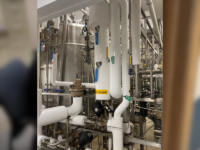Searching eBay to replace old parts for your legacy equipment? This article details how one customer successfully addressed this challenge.
In the world of pharmaceutical manufacturing, downtime can be a very costly inconvenience. While it was “state-of-the-art” when installed, our customer’s 1993 liquid vial filling line and 1985 fluid bed dryer/granulator were starting to cause unwanted downtime. The legacy equipment had been a workhorse operating for the past 20 to 30 years, but the vendors they originally purchased the equipment from no longer offered support. Problems and concerns were mounting:
- Maintenance was problematic due to the lack of part availability; they were having trouble locating refurbished parts, even on eBay.
- The 1985 fluid bed dryer/granulator system was mostly pneumatic, requiring a lot of manual adjustments to dampers, temperature control, air flow, etc. That was not a problem yet because much of their workforce had been with them for decades and have a sixth sense as to when and how to manipulate those manual sequences. However, their dependable operators and maintenance staff were approaching retirement age – how would they deal with all of that intellectual knowledge walking out the door?
- In just the case of the 16 head liquid vial fill line, approximately 2.5 million vials per week were being processed at a cost of about $1 million a week. With the amount of capital running through the legacy equipment, lack of reliability was unacceptable.
- An inflexible proprietary system limited their options. At the time the equipment was made, manufacturers sold proprietary systems that do not easily integrate with new technology. Our customer knew they could benefit from the ability to integrate new technology.
Our customer began the process of evaluating their options to either invest in new equipment or completely redesign the current equipment and install the latest control system technology. Here is the breakdown of that evaluation.
New Equipment
Pros
- State-of-the-art technology
- Most new equipment is designed with an open architecture so it can be easily connected to other technologies.
Cons
- Huge capital investment
- Lead time to order this type of equipment can be a year or more
- They would need to plan for a lengthy downtime to install, commission, test and verify the system
- In the case of a fluid bed dryer/granulator, the sheer size required (3 stories) would significantly extend downtime and require building alterations to remove the old equipment and install the new equipment
Redesign current equipment and install the latest control system technology
Pros
- Will save over 75% of cost compared to replacing with new equipment
- Will have functionality and flexibility of the newest technologies
- Open architecture allows integration of other technologies in the future
- Fully supported by vendor company
- Spare parts readily accessible
- Savings associated with maintenance
Cons
- Relying on and trusting in the expertise and knowledge of a control system integrator – can this really work?
- The risk of spending the money for an upgrade that does not meet their needs
The Decision
Relying on the reputation of Huffman Engineering, who had successfully upgraded legacy equipment for the company in the past, the pharmaceutical company decided to invest in a full redesign and controls upgrade.
The Solution Process and Implementation for Both Projects
- The first step in the process involved multiple in-depth meetings between Huffman Engineering and the customer in order to fully understand the customer’s needs, processes and requirements. Huffman Engineering is a subject matter expert in upgrading legacy equipment for the pharmaceutical industry and helped the customer understand the capabilities the upgrades could include. In addition, Huffman Engineering collaborated with the technology provider, Rockwell Automation, to provide the optimal solution. The beginning process led to the creation of a Functional Requirement Specification (FRS) to meet the customer’s expectations of the upgrades.
- With the FRS in place, Huffman Engineering designed the schematics for all parts on the upgrades, including parts of the system to be sub-contracted to others. Key project deliverables included items such as:
- PLC control
- Instrumentation
- Air flow transmitters
- Damper/actuator
- Temperature probes
- Pressure transmitters
- Duct work
- Electrical wiring
- Electrical and mechanical design
- Control panel design
- Repeatable process control with set point optimization
- Air flow
- Temperature control
- Pressure control
- HMI design displaying real-time process variables
- Planned parameters for data collection, alarming, and security
- During the project implementation phase, design meetings took place between Huffman Engineering and the customer to assure the project was on the right track and there would be no unexpected issues during start up and commissioning. Taking the time to scrutinize the system prior to installation was invaluable in addressing issues in the design phase of the project rather than waiting until the conclusion of the project.
The Results
The 1985 Fluid bed dryer/granulator
For the fluid bed dryer/granulator, not only did Huffman Engineering design and install the new control system and hardware, but also the instrumentation, air flow meters, damper/actuator, temperature probes and pressure transmitters. The equipment went from a mostly pneumatic system, which required experienced operators due to a lot of manual adjustments to dampers, temperature control, air flow, etc., to an automated, repeatable process control system new employees could easily learn to operate.
The customer gained real control of critical variables such as air flow, temperature and pressure. The real-time process variables are now monitored and controlled via the new human machine interface (HMI). Capabilities for data collection, alarming and security are added benefits.
Quality control has been greatly enhanced as the air flow before would bounce between 500-1000 Cubic Feet per Minute (cfm). Now the air flow ranges from just 50 +/- cfm. Prior to the upgrade, temperature was a guestimate, now the temperature varies by just 3 +/- degrees. Huffman Engineering also addressed the increased technical requirements for explosion protection, validation and qualification, documentation, and regulatory requirements.
The 1993 liquid fill line
The smooth upgrade of the highly-used 16 nozzle, 16 pump liquid vial equipment was extremely critical to our customer’s bottom-line revenue. A lot of high-value product flows through it daily. In order to meet the customer’s aggressive schedule of just 10 days to tear out the old and put in the new, it took considerable upfront planning for a very coordinated effort. Demolition of the old controls system began on a Friday night. Working over weekends when vendors aren’t available required our team be prepared for as many unknowns as possible. With a large onsite engineering team and thorough preparation, we actually completed the project a day ahead of schedule.
The upgrade eliminated the obsolete motion control servo drives they previously had to find replacements for on eBay. By using current technology, spare components are readily available and in the event of a component failure, the component can be overnighted from the manufacturer. Our customer now has a reliable and maintainable control system for years to come.
Instead of just an upgrade, Huffman Engineering also made improvements to the overall design. Previously, any time they had a fault, they’d have to do a reinitializing of the system which would take 15 minutes (averaging 2 times/shift). Now they only have to reinitialize if there is an overtorque fault, where the belt is disconnected from the drive to prevent damage, and it only takes approximately 30 seconds.
The new control system has 4 coordinated servo axes. Our customer wanted the ability to add more in the future and we sized the system accordingly to add 4 more. The panel is built to accommodate the hardware for that and the safety system will adapt to it.
With the new control system, safety is built into the PLC. Our customer can now control e-stops over Ethernet instead of a hardwired safety relay. Installation and troubleshooting the safety over Ethernet is much simpler than hardwired. If you lose communication with servos, VFD, or PLC the system automatically goes to a safe state (usually stopped) in just microseconds. Installation and troubleshooting the safety over Ethernet is much simpler than hardwired.
The Importance of Customer Contribution
In this project, we can’t overlook the contribution of the customer. We had a lot of excellent support and communication from maintenance and the operators. Defining the requirements was much easier. The customer team understood the tight timeframe and provided needed information accordingly. They supported us on some installation tasks and had good operator support for testing. One challenge on many jobs is that we don’t run the equipment on a daily basis, so we need someone knowledgeable to start, stop, etc. In this job, the customer did a really good job of supporting us which made the projects successful.




